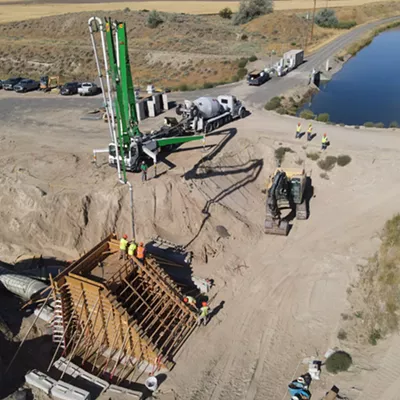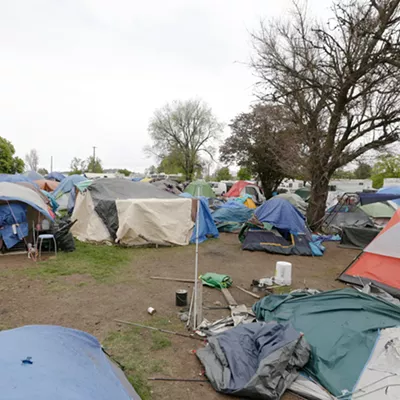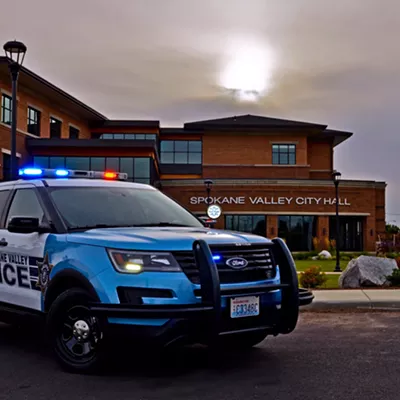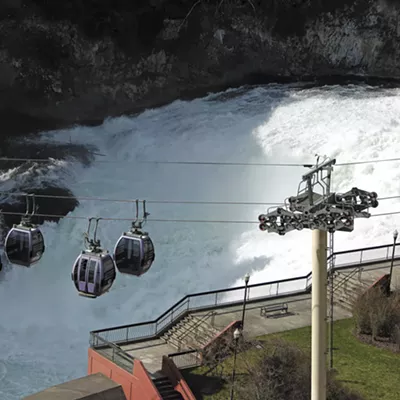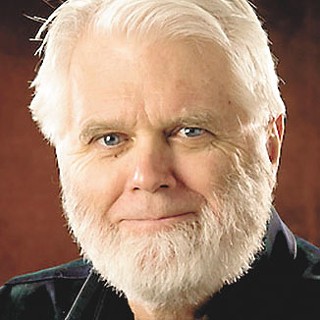This three-year-old course on the Rathdrum Prairie has already earned the title of "masterpiece" from some visitors. What's even more dramatic than a 7,450-yard course (from the championship tees) in our own backyard is the fact that it's the product of one man. The Links was designed and built by Emmett Burley, a retired tile salesman and manufacturer. After playing the game for five decades, Burley finally found himself in a position to follow his long-held dream of designing and building a traditional links course. So he did just that -- in his mid-seventies.
You won't find any so-called "signature holes" at the Links. When asked why not, Burley, who has the energy of someone half his age, mutters, "I don't go for signature holes. Designers call them signature holes because they want to sell houses."
Burley is a true throwback to golf's good old days. In fact, if he could have shaved a couple of strokes off his game in the 1950s, you might have heard his name in the same breath as Arnold Palmer.
Burley's experience and knowledge of the game runs deep. Born and raised in Zanesville, Ohio, Burley describes himself as a "Bagger Vance" kind of teenager. He caddied for the likes of Byron Nelson, Sam Snead and even, way back in 1938, Walter Hagen. Later, as a student at Ohio University, he played competitive golf with Dow Finsterwald, who would go on to win several PGA tournaments, including a PGA championship. Through his lasting friendship with Finsterwald, Burley, then a scratch golfer himself, met Palmer. That was almost 50 years ago; he remains close friends with both to this day.
I ask him why he didn't pursue golfing professionally.
"I couldn't beat Bobby Rankin," he responds.
But who was Bobby Rankin?
By way of answering, Burley recalls the college golf scene in Ohio during the late '40s and early '50s. He and Finsterwald played at Ohio University. Up the road at Ohio State, Rankin led a team that also featured Tom Strange (Curtis's dad) and Tom Nieporte, who would become a marginally successful touring pro during the '50s.
"I tried real hard to beat Bobby Rankin, but couldn't do it," recalls Burley. "Once I a posted a 69 and thought I had him. Then Rankin shoots a 65. I knew I'd never beat Bobby Rankin, or Dow or Arnold, so why think about the tour? That's when I became a tile salesman."
Burley was a success in business as Mosaic Tile's highest producer. He lived in various cities throughout the country. He came to Spokane from Seattle in the late '60s and began his business, which would become Quarry Tile. A few years back, he sold his company. Then, at an auction, he purchased the land on which he would build his dream. A little later, the railroad needed some of that land for its refueling station. Burley took his profit and set about fulfilling that dream.
And what a dream. Emmett Burley has produced what comes as close to art as golf design can get. To get the full guided tour, I played 18 holes with Burley, along with my longtime golfing companion, Kelly Farris (a seven-handicap golfer, who, when he isn't teeing it up, serves as concertmaster for the Spokane Symphony).
Unlike so many courses these days, the Links is a golfer's golf course. Indian Canyon head professional Gary Lindablad played a round and spoke of what great fun it was to hit middle irons into most par 4s. The University of Washington golf team stopped by on its way to a tournament to play a round. The students' thank-you cards are filled with words such as "Wow!" and "Awesome!" On a windy day, no one broke 70 -- the first time that had happened, according to the UW golf coach. Another collegiate golfer reported that she had, for the first time she could remember, used every club in her bag.
Others have compared the course favorably to U.S. Open venue Shinnecock Hills; others to the highly praised Bandon Dunes on the Oregon Coast. Andrew Kloprogge, head professional at Australia's Heritage Golf and Country Club (which is a Jack Nicklaus signature course), wrote that "The course is one of the best I've ever seen and played during my professional career."
Surprises abound. As you stand over your second shot on No. 5, you face a scary, crowned green that slopes away from the center in all directions, most severely from back to front. It's a green that could have been designed by legendary Scotsman Donald Ross. To hold your shot on the green from the right, you need to draw the ball into the slope. From the left, you'll need a fade. Distance accuracy is crucial.
It almost feels like you're playing No. 2 at Pinehurst, the site of the 1999 U.S. Open. And in fact you are, as Burley has replicated Ross's design at Pinehurst. It's not the same hole, of course. On the Rathdrum Prairie, you play next to naturally grown fescue rough, not Southern pine trees. Nor are the tees and driving areas the same. But Burley has succeeded in matching the experience from the approach shot through the green.
In all, seven of his greens replicate famous holes on famous courses, and Burley has the topographical maps to prove it. Play the Links, and in addition to the second and eighth holes at Pinehurst, you will be challenged by Nos. 8, 9 and 11 from Augusta, and two holes (Nos. 3 and 10) from Golf Digest's longtime top-rated course in America, Pine Valley.
Each has its own story. No. 12 at the Links is a relatively short par 4, measuring 365 yards from the white tees and 408 from the black championship tees. The green slopes sharply from right to left and from back to front. On the left side of the green, you try to avoid a very long and narrow trap.
Burley points at the trap and explains that "At Augusta, right there is Rae's Creek. Well, I don't have a creek, so I put in a trap. Heck, they've changed this green twice since I designed it. Now the creek has been cut much closer to the green, and the slope is much worse than what I have here. They want to see balls hit in to the left take the slope and roll right into the creek. I don't get it. I think the green here is very fair, just as it is."
Burley chose these holes not to make a splash, but because he had played or walked them all, knew them and was looking for holes that fit into his design and complimented the terrain. More often than not, Burley was seeking design shortcuts that he knew worked. He also wanted to provide golfers with a great putting experience as they confronted challenges that have bedeviled generations of the world's greatest golfers. It helps that his greens are extraordinary. There are none better and few as good anywhere in the Northwest.
Another hole you'll be talking about while you add up your score is No. 9, a monster 790-yard par 6.
But some of the joy of playing the Links comes from knowing Burley's story -- that he did it his way by feel, hard work and reliance on personal experience. As I drove around the course with him, he asked that I downplay his part in all this. "I want the course to be the story."
Designing and building new golf courses isn't cheap. Without the cost of the land, figure upwards of $3 million. Hire a signature pro to put his stamp on it and it goes even higher. At one time, Burley's friend Arnold Palmer -- a noted course designer himself -- offered to come out and take a look around. Burley thanked his old friend, said he would welcome his visit, but made certain that Palmer understood that this course would be Burley's own.
He and a silent partner planned to spend only $1 million, excluding the cost of his land. "Can't be done, Emmett," his many friends told him. With an I-told-you-so twinkle in his eye, he recalls: "One guy told me that I'd spend that much putting in my irrigation. I said that he might be right, but I'd looked into it and thought I could get my water on the property for much less. Turned out I was right."
The final tab on the Links came to $1,051,000.
Now he maintains it with a fraction of the people employed by other local courses. The whole thing is designed to be as carefree as possible.
"I was told that weeds hate two things," says Burley, "grass and mowing." So he uses no pesticides, he doesn't water the rough and he uses organic fertilizer. In other words, he saves money and manages to be politically correct all at the same time.
I noticed that Burley had positioned his traps well out from the greens, as had the legendary designer, Ross. When viewed from down the fairway, traps so positioned create an optical illusion. The golfer's eyes tell him that the green is closer than it really is. Ross is credited with being an illusionist. "Well, yes, that's what everyone thinks," says Emmett, "but what Ross really wanted to do was reduce his maintenance costs."
By moving the traps far enough away to permit a mower to be driven in between, you save on maintenance time and cost. Also, shots hit from traps in such positions won't spray sand onto the green.
How in the world did one man manage to pull off such an amazing feat? "I've always been able to visualize," says Burley, who neither understands nor uses e-mail, let alone computer graphics programs.
"I had an idea about what I wanted," Burley says. "I signed up for a design class back east; then I came back, mowed my property and walked it."
"You walked it?" I stammer. "Just walked it?"
"Well," says Burley, "I was advised to hire someone to do a detailed topographical map. Hell, that would have cost me $50,000. No, I just mowed it, then walked it. I got an aerial photograph and went about with my design. And that was about it."
This is a man from another era. Donald Ross likely went about designing the Pinehurst courses in much the same way. Or how about Chandler Egan, who designed Indian Canyon and worked on the redesign of Pebble Beach? He probably worked the same way, too. But today's high-tech designers, each armed with a small armada of high-end Macs? It's a totally different world now.
Burley is, and was, a self-admitted design amateur. So he sought and received some help from Keith Hellstrom, who worked on Deer Park, among other courses, and whom Burley credits with providing invaluable advice about the greens. Others offered advice, too, and Burley borrowed what he needed to borrow. In the end, however, the course reflected his own vision of what a links course should look and feel like.
This vision extends to the tiniest details. On the thirteenth green, Burley calls my attention to the road behind the green. As a car approaches, Burley breaks into a big smile and tells me to watch closely. Sure enough, as the car enters into the view corridor extending from the green when the golfer faces the road, it magically disappears from view. Burley seems particularly proud of this little detail. "See there, the road drops down behind those trees. I mounded some dirt and as a result of the dip and the mounds, you can't see the car."
Later in the round, he points out that he had also used mounding to hide houses in the distance. Emmett likes courses, not housing developments, and he wants the golfer to feel the place, unhindered by visual clutter. Again, he succeeded.
On No. 15, Farris strokes a 5-iron off the tee. It's an uphill, 170-yard par 3. The green is a replica of No. 10 at Pine Valley. A very deep pot bunker fronts the green -- the kind you rarely meet on American golf courses. The pin is 20 feet above the bunker, right in line with the tee. It's an intimidating tee shot, as the green slopes sharply from back to front and from left to right. His shot looks good -- until it disappears into the bunker.
With great enthusiasm, Farris climbs down into the bunker, the pin barely visible. He lays open his wedge and explodes the shot. The ball flies up, but clips the rim of the trap. With its arc destroyed, the shot flattens out, briefly flirting with disaster. But the ball manages to roll forward, weakly bouncing a couple of times and coming to rest some seven feet from the hole. It wasn't pretty, but the shot draws applause from both of us. Kelly was in play. A triumph.
After losing track of the goings on up at the green, I ask Burley, "Did Kelly make that putt?"
"Nope," Burley answers with a mischievous smile. "He knew I was going to get my par putt in, and he choked."
Yes, Burley's still a competitor. In fact, he has shot his age from the blue tees. But he is, after all, 76, and how much longer can he get up at 5 am and make so many decisions and continue to shoot his age? He mentions his out option, should the course not work out.
"I could, I suppose, plow it all up and turn it into an industrial park," he says. Some with whom I discussed the situation have been led to believe that Burley is closer to making that call than he let on to us. No doubt, the course needs a more focused marketing effort. Its very location remains a mystery to many. And without those houses next to "signature holes," the course remains dependent on greens fees.
America, moreover, is saturated with golf courses. Across the mountains to the west, the highly regarded McCormick Woods and the newer designer course, Trophy Lakes, are struggling. So the situation with the Links remains fragile. Burley wouldn't be the first artist to paint over a canvas that most regarded to be a masterpiece. Let's hope, however, that this doesn't become the fate of this celebration of golf. These days, courses like his seldom come to us.
It may well be, however, that Burley needs the course more than he knows. A while ago he learned that his old rival and friend Bobby Rankin had died.
"Bobby Rankin died," he reported to his wife, Helen.
She paused and answered: "Emmett, Bobby Rankin should have built a golf course."
To get to the Links from Interstate 90, take Exit 2 in Post Falls (at the Outlet Mall). Head north to Seltice Way. Turn right. After two signals, you are at Chase Road. Take a left, and proceed four miles north to the road's dead end. Call: (208) 777-7611.
Publication date: 07/31/03



